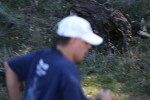Coyote Lake Harvey Bear Ranch County Park
Date: (Sun.) Jan. 28, 2024
Location: Gilroy, CA
Event Director: - 650.906.9672
Course Setters: Theo Verhoeven, Tom de Vre
Type: B; Standard 7-course event for beginners through advanced; back at the Coyote Lake side of the park as in previous years; beginners are welcome and can learn about orienteering at free Beginner Clinics
Related Event Information
Course Setters’ Notes
By Tom De Vre & Theo Verhoeven
Now is the best time of the year to come and visit Coyote Lake Harvey Bear, as the ground has softened after the winter rains. The park features open oak forests covering the rolling hills west of the 3-mile-long Coyote Lake. We offer you seven Classic courses for beginners and advanced orienteers to enjoy the most scenic parts of this park.
Course Details
Water
Course Length Climb Controls Stops Navigation Map Scale Map Size
White 2.4 km 115 m 4.8% 11 0 Beginner 1:7,500 8½"x11"
Yellow 3.2 km 75 m 2.3% 9 0 Adv. Beginner 1:7,500 8½"x11"
Orange 3.8 km 195 m 5.1% 14 1 Intermediate 1:7,500 8½"x11"
Brown 3.4 km 130 m 3.8% 11 1 Advanced 1:7,500 8½"x11"
Green 4.4 km 215 m 4.9% 13 2 Advanced 1:10,000 8½"x11"
Red 6.1 km 310 m 5.1% 14 2 Advanced 1:10,000 8½"x11"
Blue 8.0 km 410 m 5.1% 18 3 Advanced 1:10,000 11"x17"
- Beginners should be aware that the course lengths shown are the cumulative straight-line distances between controls. Your actual distance will be somewhat longer, even if you don't make any errors. The climb numbers represent the amount of ascending that would be done on the "optimum route" (in the Course Setters’ opinion), without regard for any descending.
The map contour interval is 5 m.
The Start for all the courses is about 0.5 km (with 40 m climb) from the assembly area. Please follow the streamers to the Start area.
Map and Terrain
Note: Please pay attention that the magnetic-north lines on all the maps are not parallel to the edge of the paper — they are at approximately a 15-degree angle.
Although last updated in 2019, the map is still quite good and reliable. Still, in some areas, it might be harder to distinguish mapped individual trees and forested areas or copses in the field.
The brown × denotes a fallen tree or root stock. The green × denotes a dead tree that is still standing. Over the last couple of years, there are many more fallen and dead trees in the field that are not on the map, and some mapped ones might be difficult to see. But when these features are used as controls, they are in an area of the map where they can’t be confused.
Green dots of various sizes on the map can either denote a small lone tree or a bush.
Hazards and Wildlife
Poison oak is present in the park, but is easily avoided on all of the courses. Most of the poison oak is still leafless this time of year, so it may be harder to recognize (but it is still a hazard).
In some areas of the park, and for all the intermediate and advanced courses, you will go through terrain with scattered small rocks that can cause a fall or twisted ankle if one is not paying attention or is going at very high speeds.
Most of the wildlife, such as wild pigs, turkeys and deer, that roam these hillsides will not pose a problem, as they will most likely run away when they hear or see you. There are also cows that graze in this park, so please run around groups of cows as to not startle them (and never get between a calf and its mother!). When encountering horses and riders on the trails, do not startle them and give them right of way.
Course Comments
The White (beginner) course follows trails, but is not stroller accessible as some sections of the trail are too rocky and steep, and potentially also muddy if it has rained in recent days. There is also some considerable climb (115 m) on this course. But you will be rewarded with beautiful views of the surrounding hills and canyons to the east.
The Yellow (advanced beginner) course also mainly follows trails, but it offers some opportunity to go off-trail, and, although the controls are visible from the trail, you will have to leave the trail near the control area to find and punch the control.
There is no overlap between the White and Yellow courses, so you could do both!
The Orange (intermediate) course goes off-trail, following along easily recognizable features such as spurs, reentrants, and gullies. The total climb is considerable (195 m). There will be one water control on this course. There is no need to cross barbed-wire fences.
On the Brown (advanced) course, the total climb for the most optimal route has been minimized while still offering some navigational challenges. Please note: Right after the Start, a fence is marked with purple ×s on the map to indicate a forbidden route. The fence is quite difficult to cross and, to be fair, we eliminated this route choice. You will need to find an alternate route. There is no need to cross any other barbed-wire fences on this course. There will be one water control on this course.
The Green, Red, and Blue (advanced) courses venture further into the park. Except for the Blue course, there is no need to cross any barbed-wire fences. If you are on Blue and choose to cross a fence, you must go under as to not damage any fences. The Green course has two water controls. Red has no water controls, but twice passes a water stop indicated on the map with the water-cup symbol (located at a gate in a fence). Blue has one water control, and also twice passes that water stop.
Enjoy!

